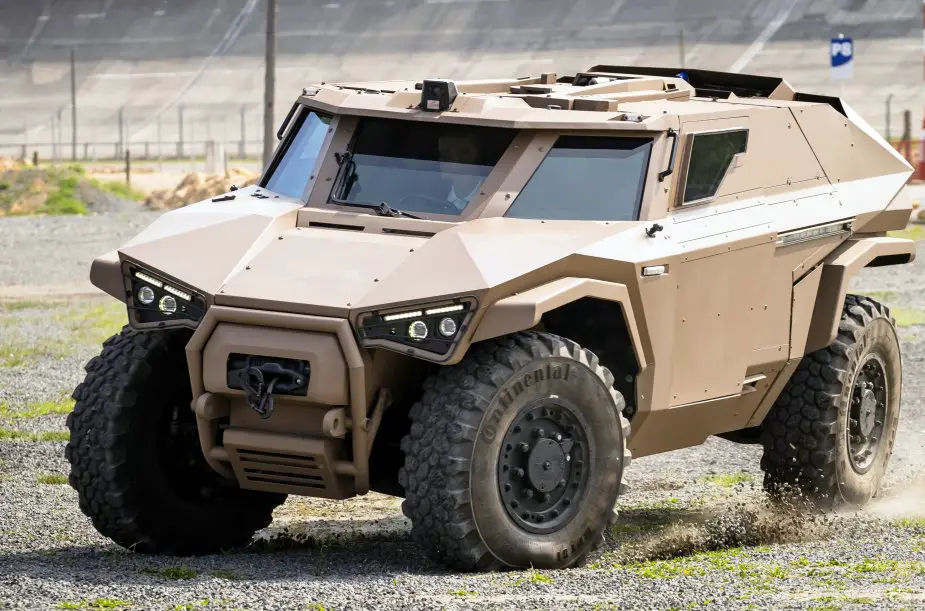Version française de cet article cliquez ce lien
The Scarabee is an unprecedented vehicle that was developed on own funds, in just nine months. The objective is to later propose it as a competitor in the program of what the French army calls VBAE, the future Armored Vehicle of Assistance to the Commitment, that will succeed the VBL (Light Armored Vehicle) and VB2L. The Scarabee is also presented at the ARQUUS Virtual Defense Exhibition EXPO.
Follow Army Recognition on Google News at this link

Arquus Scarabee, a revolutionary tactical vehicle demonstrator (Picture source: Arquus)
The Scarabee is a diesel-electric hybrid, light armored 4-wheel drive vehicle designed for reconnaissance and combat support. It was developed on own funds in just nine months by a team of six (originally) and later up to less than twenty people. It was necessary to validate one by one different possible uses before continuing the progression. Objective: to later propose a competitor in the program of the future Armored Vehicle of Assistance to the Commitment (Véhicule Blindé d’Aide à l’Engagement, VBAE) which will succeed the VBL (Véhicule Blindé Léger, Light Armored Vehicle) and VB2L.
The size of the Scarabee is a little larger than that of the VBL but its versatility, transport capacity and modularity will be much greater. The vehicle is not yet amphibious but this ability is considered; its batteries - which can be reloaded very quickly - can already be fully immersed and the roof air intake protects the engine from any wet breaks (it already prevents clogging of the radiator by mud and sand).
The Scarabee is somewhat a revolutionary vehicle by several characteristics: the squat form limited to 1.90m high, the driver in the center front seat, the three soldiers’ seats in the rear center position, in front of the engine compartment, the sliding doors (replaceable by conventional doors on request) electrically or manually operated and partially opening the roof to facilitate fast access and exit of loaded occupants, the formidable 4x4x4 transmission which allows the vehicle to move conventionally or sideways (in “crab”) and turn within a less than a 5-meter radius. The front wheels are controlled by a conventional steering wheel, while the rear wheels are, for the moment, controlled by a joystick but everything will later be gathered in the steering wheel. A driver needs only two hours to master the behavior of the Scarabee in all the variety of management possibilities. In addition to a direct view of almost 180°, the driver has two cameras that complete a 360° vision.
The ground clearance is adjustable between 40 and 50 cm. The tires identical to those of the Sherpa will of course be equipped with an inflation/deflation system.
The demonstrator has a double floor and may (a more and more frequent option) receive additional armor kits adapted to the dangerousness of each mission. In total, the mass of the Scarabee will be about 8 tons, including 2 tons of payload. Three vehicles can be loaded into an Airbus A400M Atlas.
Regarding its armament, the Scarabee can receive a remote-controlled weapon station armed with a .50 machine gun or a 30mm gun, for instance. Other possibilities: a grenade launcher, a radar, etc., the roof can be adapted to many options.
The engine of the Scarabee was designed as a diesel-electric hybrid, with a 300 hp engine and a 75 kW electric motor powered by two Li-Ion batteries, a combination that takes advantage of tests conducted with the VAB Mk.3 Electer. This formula offers a weight/power ratio that is half more than the Sherpa Light’s one. Electric propulsion can operate in four modes: hybrid, boost by cumulating the electric and diesel propulsion modes, electric alone to reduce the thermal and sound footprint, and generator to power or reload other systems, a requirement that we found on a growing number of military vehicles of all sizes.
An asset that will greatly relieve the mechanics and some logisticians, the engine is fixed on a sliding rack, which will provide better accessibility during the maintenance and replacement phases.This system allows the replacement of the engine in less than 45 minutes.














